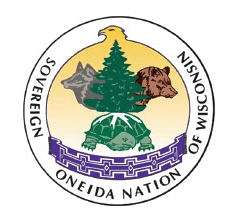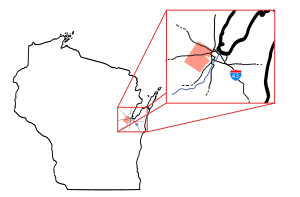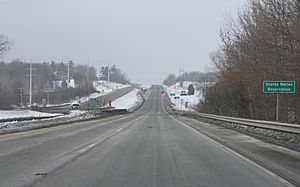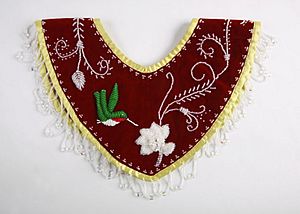Oneida Nation of Wisconsin facts for kids
| Onʌyoteˀa·ká (Oneida) | |
|---|---|

Oneida Nation tribal seal
|
|
| Total population | |
| 16,567 (2010) | |
| Regions with significant populations | |
| Wisconsin | |
| Languages | |
| English, Oneida | |
| Religion | |
| Christianity, Native | |
| Related ethnic groups | |
| Oneida Indian Nation of New York Oneida Nation of the Thames Mohawk, Onondaga, Cayuga, Seneca, Tuscarora |
The Oneida Nation is a federally recognized tribe of Oneida people living in Wisconsin. A "federally recognized tribe" means the U.S. government officially acknowledges them as a sovereign nation with their own government. The Oneida Nation's special land, called a reservation, is located west of the city of Green Bay, Wisconsin.
This reservation was created by a special agreement, or treaty, in 1838. At first, parts of the land were given to individual Oneida families. Later, in 1934, the tribe was able to take back control of its land as a group.
In the early 1900s, some tribal members lost their land due to unfair sales. The Oneida people used their land for farming and cutting timber. As of 2010, the Oneida Nation controls about 35% of the land within its reservation. They are working hard to get more of their original land back.
In 1988, the Oneida Nation started the first modern lottery in Wisconsin, called Big Green. Since then, they have also opened a casino called Ashwaubenon Casino on their land. This casino helps the tribe earn money for new businesses and to support their community. Out of more than 16,000 members, about half live on the reservation.
Contents
History of the Oneida Nation
The Oneida Nation is a group of Indigenous people who speak an Iroquoian language. Their ancestors originally came from what is now central-eastern New York. They were one of the first five nations to join the powerful Haudenosaunee (Iroquois) Confederacy. This was a strong alliance of Native American nations.
During the American Revolutionary War, many Oneida people, especially those known as the Christian Party, sided with the American rebels. After the war, the tribe faced pressure to give up their lands in New York to the new U.S. government. European-American settlers also moved onto their territory. The Oneida people were often treated badly by settlers who didn't know the difference between tribes who had been allies and those who had fought against them. Because of this, many Oneida began to move from New York to Wisconsin in the 1820s and 1830s, where they were offered new land.
In 1838, the Oneida accepted a reservation in Wisconsin through a treaty. Chief Patrick James Brault worked to make sure the land would be owned by the tribe as a whole, not by individuals. Important Oneida activists like Laura Cornelius Kellogg (1880-1947) from Wisconsin and New York continued to fight for Native American land rights.
The 20th Century for the Oneida
Life During the Great Depression
During the Great Depression, a tough economic time in the 1930s, the U.S. government created programs to help people. One program, the Works Progress Administration (WPA), started the Federal Writers Project. This project helped create state guides and also worked to save parts of the Oneida culture. Their "Oneida Language and Folklore Project" collected many stories and cultural information.
Changes in Government Policy
After World War II, the U.S. government had a policy called "Indian Termination." This policy aimed to end the government's special relationship with Native American tribes. The idea was to make tribal members more like other U.S. citizens, ending tribal self-governance and special protections for reservations.
In 1946, the Indian Claims Commission was set up. Its goal was to settle old complaints tribes had against the U.S. government, like broken treaties or unfair land deals. Tribes had five years to file their claims.
In 1953, the U.S. Congress announced its official policy of Indian termination. This policy suggested ending federal aid and services to Native people and ending the government's management of reservations. It also said that individual members of terminated tribes would become full U.S. citizens.
However, the Oneida, along with the Stockbridge-Munsee and Brotherton tribes in Wisconsin, fought back. They started legal cases in the 1950s to protect their land claims from New York. Because of their efforts, the government decided not to terminate these tribes. This allowed the Oneida Nation to continue as a recognized tribe with their own government.
Oneida Reservation
The Oneida Reservation is located in parts of Outagamie and Brown counties in Wisconsin. It's shaped like a rectangle that points northeast, following the Fox River. The reservation covers about 102 square miles, with most of it being land.
As of 2010, only about 35% of the Oneida Reservation was owned by the tribe. A long time ago, government policies allowed much of the reservation land to be sold to individuals, including many non-Native people. Because of this, parts of the reservation are now within the cities of Green Bay, Hobart, and Ashwaubenon. The western part of the reservation includes the community of Oneida. The Oneida Nation is actively working to buy back more land within its reservation borders.
People on the Reservation
According to the 2020 census, about 27,110 people live on the Oneida Reservation. The population is made up of people from many different backgrounds. About 16.8% of the people are Native American, while 71.4% are White. There are also smaller numbers of Asian, Black, Pacific Islander, and people of two or more races. About 5.1% of the population is Hispanic or Latino.
Tribal Membership
As a sovereign nation, the Oneida Nation sets its own rules for who can be a member. To join, people need to show that they have at least 1/4 Oneida blood. This is sometimes called "blood quantum." Unlike some other tribes, they do not require that your ancestry comes only through your mother's side of the family.
Economy of the Oneida Nation
For many years, the Oneida economy was based on farming and cutting timber. During the New Deal in the 1930s, government programs like the Works Progress Administration and the Civilian Conservation Corps helped create jobs and build important things for the community.
In the mid-1980s, the Oneida Nation started a bingo game that was even shown on TV in Green Bay. This was an early step into gaming.
In 1988, the Oneida Nation sold the first "modern" lottery tickets in Wisconsin. This was before the state itself started its own lottery. The main game they offered was called Big Green.
Since then, the Nation has built the Ashwaubenon Casino on their reservation. This casino offers gaming and entertainment. The money earned from the casino helps the tribe invest in new businesses and support their community. The casino complex also includes a hotel and conference facilities. Thanks to gaming, the Oneida tribe has gone from being a struggling community to one with more social and economic success. They have even sponsored the Green Bay Packers football team!
The money from the tribe's businesses helps its members in many ways. Oneida members can get help with dental, medical, and eye care insurance, and even college education costs. They also receive annual payments from the casino's profits.
The Oneida Nation is now one of the biggest employers in northeastern Wisconsin, with over 3,000 employees. About 975 of these work for the tribal government. The tribe also manages many programs using money from federal and private grants.
Notable Oneida People
- Daniel Bread: A long-time chief who helped create the 1838 treaty for the reservation.
- Charlie Hill: A well-known comedian.
- Laura "Minnie" Cornelius Kellogg (1880-1947): An author, speaker, and activist who fought for Native American rights.
- Lillie Rosa Minoka-Hill: A Mohawk doctor who married an Oneida man and cared for reservation members for decades. The Oneida adopted her in 1947 to honor her work.
- Paul Powless: A leader who opposed the idea of dividing tribal lands in the 1870s.
- Purcell Powless: Tribal chairman (1967–1990) who led the tribe when they started their gaming casino.
- Levi Parker Webster (1883-1962): An athlete.
- Martin Wheelock: A famous football player at the Carlisle Indian School.
- Dennison Wheelock: A composer, conductor, and cornet soloist from the late 1800s and early 1900s.
- James Riley Wheelock: A musician, conductor, and clarinet soloist.
- Roberta Hill Whiteman: A poet and professor at the University of Wisconsin.
- Neilson Powless: A professional road racing cyclist.
Communities on the Reservation
- Ashwaubenon (part)
- Chicago Corners
- Green Bay (part)
- Hobart (all)
- Howard (part)
- Oneida
Points of Interest
- Austin Straubel International Airport
- Duck Creek Trail




